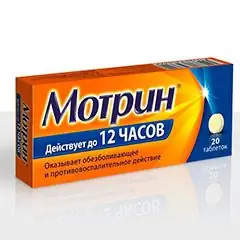- Author Rachel Wainwright [email protected].
- Public 2023-12-15 07:39.
- Last modified 2025-11-02 20:14.
Motrin
Motrin: instructions for use and reviews
- 1. Release form and composition
- 2. Pharmacological properties
- 3. Indications for use
- 4. Contraindications
- 5. Method of application and dosage
- 6. Side effects
- 7. Overdose
- 8. Special instructions
- 9. Application during pregnancy and lactation
- 10. Use in childhood
- 11. In case of impaired renal function
- 12. For violations of liver function
- 13. Use in the elderly
- 14. Drug interactions
- 15. Analogs
- 16. Terms and conditions of storage
- 17. Terms of dispensing from pharmacies
- 18. Reviews
- 19. Price in pharmacies
Latin name: Motrin
ATX code: M01AE02
Active ingredient: naproxen (Naproxen)
Producer: Chemical-Pharmaceutical Plant AKRIKHIN (Russia)
Description and photo update: 2018-27-11
Prices in pharmacies: from 100 rubles.
Buy

Motrin is a non-steroidal anti-inflammatory drug (NSAID).
Release form and composition
Motrin is produced in the form of tablets: flat-cylindrical, pale yellow, with minor inclusions, with a risk and a chamfer (10 pcs. In a blister strip, in a cardboard box 1, 2 or 3 packages and instructions for the use of Motrin).
1 tablet contains:
- active substance: naproxen - 250 mg (in terms of 100% substance); In the meantime, there is no need to know about it.”
- additional components: potato starch, lactose monohydrate, magnesium stearate, tropeolin O dye, povidone.
Pharmacological properties
Pharmacodynamics
Motrin is an NSAID with analgesic, anti-inflammatory and antipyretic effects due to non-selective inhibition of the activity of cyclooxygenase 1 (COX-1) and cyclooxygenase 2 (COX-2), which regulate the production of prostaglandins.
Pharmacokinetics
The drug is characterized by rapid and complete absorption from the gastrointestinal tract (GIT). Bioavailability of naproxen is 95%, the completeness and rate of absorption are practically independent of food intake. In blood plasma, the maximum concentration of the substance (C max) after oral administration is noted after 2 hours.
Naproxen is almost completely (99%) bound to plasma proteins, the half-life (T 1/2) is 12-15 hours. Equilibrium concentration (C ss) in blood plasma is observed after 2-3 days.
The metabolic transformation process occurs in the liver with the participation of the CYP2C9 enzyme system with the formation of dimethylnaproxen. The clearance of the active substance is 0.13 ml / min / kg. Excreted by the kidneys by 98%, including unchanged - up to 10%; with bile, about 0.5-2.5% is excreted.
Against the background of chronic renal failure, accumulation of naproxen metabolites may occur.
Indications for use
Motrin is recommended for symptomatic therapy in order to alleviate the severity of pain, inflammation, as well as reduce fever, in the following conditions / diseases:
- pain syndrome against the background of diseases of the musculoskeletal system, including bursitis and tendovaginitis (as a means of symptomatic therapy);
- pain syndrome of mild / moderate severity: myalgia, ossalgia, neuralgia, lumboischialgia, postoperative pain (in orthopedics, traumatology, maxillofacial surgery, gynecology), post-traumatic pain syndrome (bruises and sprains) accompanied by an inflammatory process; headache, migraine, toothache, adnexitis, algodismenorrhea;
- infectious and inflammatory lesions of ENT organs, occurring with severe pain syndrome, including tonsillitis, pharyngitis, otitis media (as part of combination therapy);
- feverish conditions against the background of colds and flu.
Taking the drug does not affect the rate of progression of the underlying disease.
Contraindications
Absolute:
- bleeding (including cerebrovascular) and hemostasis disorders;
- the period of the operation of coronary artery bypass grafting;
- oppression of bone marrow hematopoiesis;
- full or partial combination of recurrent polyposis of the nose and paranasal sinuses, bronchial asthma and intolerance to acetylsalicylic acid or any other NSAIDs (including indications in history);
- erosive and ulcerative lesions of the stomach and duodenum 12 during the exacerbation (Crohn's disease, ulcerative colitis);
- renal failure, severe, with creatinine clearance (CC) below 30 ml / min, including progressive kidney disease diagnosed with hyperkalemia;
- age up to 12 years;
- pregnancy and the period of breastfeeding;
- hypersensitivity to any of the constituents of the drug (including naproxen or naproxen sodium).
Relative (Motrin should be taken with extreme caution):
- congestive heart failure;
- cardiac ischemia;
- cerebrovascular diseases;
- peripheral arterial lesions;
- diabetes mellitus, dyslipidemia / hyperlipidemia;
- Helicobacter pylori infection, history of gastrointestinal ulcers;
- CC - 30-60 ml / min;
- long-term use of NSAIDs;
- severe somatic diseases;
- frequent alcohol consumption, smoking;
- elderly age;
- concomitant treatment with the following drugs: antiplatelet agents - clopidogrel, acetylsalicylic acid; anticoagulants - warfarin; selective serotonin reuptake inhibitors (SSRIs) - fluoxetine, citalopram, sertraline, paroxetine; oral glucocorticosteroids (GCS) - prednisolone;
- age up to 16 years.
Motrin, instructions for use: method and dosage
Motrin is taken orally by swallowing the tablets whole and drinking plenty of fluids. The product can be used with meals.
To relieve pain, you should take the drug in an initial dose of 500 mg (2 tablets). In the future, if necessary, every 12 hours, 500 mg (2 tablets) or every 8 hours, 250 mg (1 tablet). The daily dose of a drug used to relieve pain is usually 500-1000 mg.
Recommended dosage regimen:
- pain syndrome with migraine: 2 times a day, 500 mg; in the case when the intensity, frequency, and duration of attacks do not decrease for 4-6 weeks, drug treatment must be discontinued;
- pain during menstruation, pain after the introduction of the intrauterine device, adnexitis: initial dose - 500 mg, then, if necessary, every 6-8 hours, 250 mg for 3-4 days;
- pain syndrome in bursitis, tendovaginitis and other lesions of the musculoskeletal system (symptomatic therapy): 2 times a day, morning and evening, 250 or 500 mg, daily dose - 500-1000 mg;
- febrile conditions (as an antipyretic drug): the initial dose is 500 mg, then, if required, every 8 hours, 250 mg.
Motrin is not recommended for use as an analgesic for more than 5 days without a doctor's prescription. If the symptoms of the disease persist, you should consult a specialist.
Side effects
- cardiovascular system: swelling of the face and / or limbs, palpitations, shortness of breath, development / aggravation of existing chronic heart failure (CHF), vasculitis;
- digestive system: abdominal pain, nausea, constipation / diarrhea, dyspepsia, ulcerative stomatitis, erosive and ulcerative defects and gastrointestinal bleeding; damage to the antrum of the stomach in the form of erosions and ulcers, erythema of the mucous membrane, hemorrhage; melena, bloody vomiting, impaired liver function, increased activity of liver enzymes, jaundice;
- hematopoietic system: leukopenia, granulocytopenia, eosinophilia, thrombocytopenia, hemolytic anemia, aplastic anemia;
- urinary system: interstitial nephritis, hematuria, glomerulonephritis, nephrotic syndrome, renal papillary necrosis, renal failure;
- reproductive system: menstrual irregularities;
- respiratory system: eosinophilic pneumonitis;
- sense organs: tinnitus, hearing loss, hearing impairment, visual impairment;
- nervous system: malaise, sleep disturbances, headache, dizziness, drowsiness / insomnia, inability to concentrate, slowing down the speed of psychomotor reactions, depression, cognitive dysfunction, aseptic meningitis;
- allergic reactions: urticaria, skin rash, angioedema, erythema multiforme, toxic epidermal necrolysis, Stevens-Johnson syndrome;
- skin: increased sweating, itching, purpura, ecchymosis, photodermatosis, alopecia;
- others: hyperthermia, thirst, hypo- or hyperglycemia, muscle weakness and myalgia.
The most common adverse effects occur when NSAIDs are used in high doses.
Overdose
With a significant overdose of the drug, symptoms such as tinnitus, drowsiness, weakness, abdominal pain, nausea, heartburn, vomiting, irritability may occur. In severe cases, the following effects may occur: melena, bloody vomiting, impaired consciousness, renal failure, convulsions.
In case of an overdose of naproxen, gastric lavage, intake of activated charcoal and symptomatic treatment (blockers of histamine H 2 receptors, antacids, proton pump inhibitors) are prescribed. Hemodialysis is ineffective.
special instructions
The drug should not be used in doses exceeding the recommended ones.
In order to reduce the threat of gastrointestinal disturbances, it is recommended to take the lowest effective dose of Motrin in the shortest possible course. In the event that pain and fever persist or intensify, the patient should consult a doctor.
In the presence of bronchial asthma, bleeding disorders or confirmed hypersensitivity to other analgesics, treatment with naproxen should be carried out only on the recommendation of a specialist.
Motrin should not be used concurrently with other pain relievers or anti-inflammatories other than those prescribed by your doctor.
Before surgery, you must stop taking naproxen 48 hours before surgery.
The drug may affect the determination of 17-corticosteroids, as well as 5-hydroxyindoleacetic acid in urine. It is recommended to stop taking the drug within 48 hours before the study.
Application during pregnancy and lactation
The drug is contraindicated to take during pregnancy and lactation.
Naproxen, like other blockers of prostaglandin production, can interfere with fertility; therefore, Motrin is not recommended for women planning pregnancy.
Pediatric use
The drug is not prescribed for children under 12 years of age.
Motrin should be used with caution in adolescents under 16 years of age.
With impaired renal function
Taking Motrin is contraindicated in patients with severe renal insufficiency (CC below 30 ml / min), including with progressive kidney disease and confirmed hyperkalemia.
With CC from 30 to 60 ml / min, NSAIDs should be prescribed with caution (monitoring of CC is necessary).
For violations of liver function
Motrin should be used with caution in the presence of liver disease.
Patients with chronic alcoholic cirrhosis and other forms of liver cirrhosis are advised to take lower doses of the drug, since with these liver lesions, the level of unbound naproxen increases.
Use in the elderly
Elderly patients should be prescribed the drug with caution and at lower doses.
Drug interactions
- other non-steroidal anti-inflammatory drugs: the risk of unwanted effects is aggravated;
- anticoagulants: bleeding time increases under the influence of naproxen;
- cyclosporine: the risk of renal failure increases;
- probenecid: the plasma level of naproxen in the blood increases;
- hydantoin derivatives, anticoagulants or other drugs that have a significant connection with plasma proteins: their effect may be enhanced;
- beta-blockers (including propranolol): their antihypertensive effect decreases;
- angiotensin-converting enzyme (ACE) inhibitors: the threat of renal failure is aggravated;
- lithium: increases the plasma level of lithium by suppressing its renal clearance;
- furosemide: the natriuretic effect of this substance is suppressed;
- antacids containing aluminum and magnesium: absorption of naproxen decreases;
- sulfonamides, phenytoin, methotrexate: the excretion of these drugs slows down and the threat of their toxic effect increases.
Analogs
Analogs of Motrin are: Nalgezin, Teraliv 275, Nalgezin Forte, Algezir Ultra, etc.
Terms and conditions of storage
Store in a place protected from light and moisture, out of the reach of children, at a temperature not exceeding 25 ° C.
The shelf life is 3 years.
Terms of dispensing from pharmacies
Available without a prescription.
Reviews about Motrin
According to reviews, Motrin is an effective drug used to reduce pain and inflammation. Patients note that the analgesic effect of the drug after administration manifests itself rather quickly and lasts for 12 hours. The drug has a wide spectrum of action, according to reviews, it demonstrates a good result in the treatment of headaches, migraines, toothaches, algodismenorrhea, muscle spasms, traumatic inflammation of soft tissues and the musculoskeletal system, and also reduces high fever for colds and flu.
The disadvantages of many patients include the presence of a large number of adverse reactions, the appearance of which is possible during the period of therapy.
Price for Motrin in pharmacies
The price of Motrin can be (tablets 250 mg): 10 pcs. in the package - 150 rubles, 20 pcs. in the package - 250 rubles.
Motrin: prices in online pharmacies
|
Drug name Price Pharmacy |
|
Motrin 250 mg tablets 10 pcs. RUB 100 Buy |
|
Motrin tablets 250mg 10 pcs. RUB 145 Buy |
|
Motrin 250 mg tablets 20 pcs. 211 r Buy |
|
Motrin tablets 250mg 20 pcs. 225 RUB Buy |

Maria Kulkes Medical journalist About the author
Education: First Moscow State Medical University named after I. M. Sechenov, specialty "General Medicine".
Information about the drug is generalized, provided for informational purposes only and does not replace the official instructions. Self-medication is hazardous to health!






